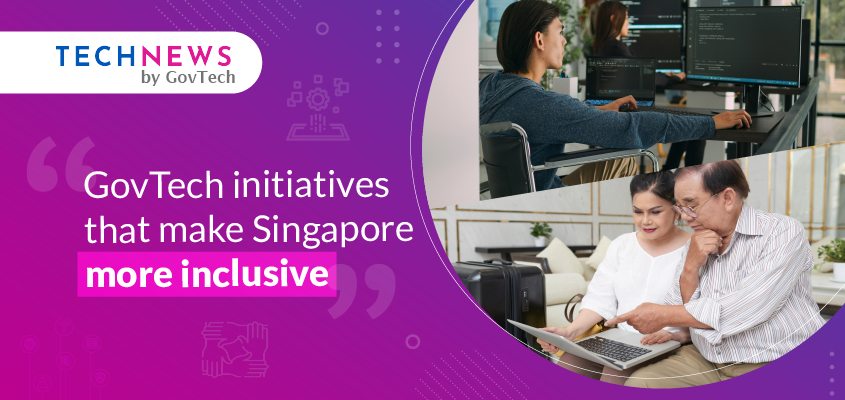These apps are helping Singapore become more inclusive

The world has experienced an explosion in technology over the past few years and Singapore is no exception.
Cashless payments have become a way of life, even at hawker centres. Today, many government services can be accessed easily and quickly by people who are digital natives.
This is mostly good, but new technological developments often serve the mass market first. This means that people with different needs and lower socioeconomic status can get left behind due to the sheer speed at which change is happening.
In response, GovTech has been striving to make life in Singapore inclusive. Our team relentlessly experiments and tests solutions to close gaps, if any. Sometimes they work out, sometimes they don’t.
MoneySound: An attempt to help hawkers deal with the digital divide
You might not have heard this, but a product called MoneySound was previously in the works. Let us explain.
When accepting digital payments, hawkers in Singapore – especially the elderly ones – might have trouble keeping track of their digital payments when they’re also taking orders, preparing the food, and serving customers.
In fact, The Straits Times reported that in 2020, some dishonest folks created fake payment screenshots to mislead hawkers into thinking they received payment.
In response, MoneySound was developed by a three-man GovTech team. The product aimed to introduce audio alerts for digital payments, inspired by devices in other countries that assist vendors in tracking transactions without constant monitoring.
The team developed a ‘proof-of-concept’ prototype within two months, but upon further exploration, hawkers’ feedback was tepid. Many were concerned about the inconvenience of installing and maintaining an additional device in their stalls.
Given these concerns and the hawkers’ reluctance to adopt the technology, GovTech decided to pause development three months into the project.
Experimentation and failure is part of the process
While the MoneySound project did not progress as hoped, its conception and temporary setback underscore GovTech’s commitment to bridging the digital divide and ensuring technology benefits all segments of society, not just the tech-savvy.
In the words of Senior Minister of State Janil Puthucheary, Singapore needs to be bold in exploring different solutions, building prototypes quickly, testing them with real users, and scaling the most promising ideas.
While not all experiments may yield the desired results the insights gained from setbacks are invaluable for future iterations!
As Singapore continues to push the boundaries of digital inclusion, it is clear that the journey is as much about the innovations that take off as it is about those that do not.
Some innovations that took off include solutions such as;
- Purple A11y
- My Legacy
- Scamshield App and Bot
Ensuring digital services are accessible with Purple A11y
Developed by the Accessibility Enabling Team (A11y Team), Purple A11y is an open-source tool that developers can use to help them build more inclusive products during the product development process.
The customisable and automated tool allows software development teams to find and fix accessibility problems to help persons with disabilities (PWDs) and the elderly access digital services more easily.
Using a bot, Purple A11y allows product development teams to rapidly scan and check for potential accessibility issues from their development machines. These include issues such as: improper labelling of buttons, images, or missing alternative (alt) text.
Making conversations about death easier with MyLegacy
Talking about one’s death is understandably difficult, but Singapore is showing changing attitudes towards conversations surrounding this subject. One way GovTech is doing its part is MyLegacy. This is a comprehensive digital portal designed for Singaporeans to securely plan and store important documents related to legal, healthcare, and estate matters.
Through this, we’ve transformed the way Lasting Powers of Attorney (LPA) are created, making the process significantly more accessible for citizens. By collaborating with the Office of the Public Guardian (OPG) and the Ministry of Social and Family Development (MSF), we’ve digitised and streamlined the LPA application process, cutting down the turnaround time from three weeks to just 15 minutes. This initiative not only simplifies the process but also promotes early planning for personal well-being.
Since its rollout, we’ve received over 57,000 LPA applications, reflecting high user engagement and satisfaction. MyLegacy’s intuitive design, featuring digital signatures and the capability to pre-fill data, along with the temporary waiver of the application fee, has made the LPA application process far more approachable for everyone.
Protecting would-be scam victims with ScamShield app
Scams have been a major problem in Singapore in the past few years, with Singaporeans losing over S$600 million in scam per year. Scammers change their tactics often, and have become extremely convincing too.
That’s why the government launched ScamShield in 2020, an app that helps individuals protect themselves against scam calls and text messages.
ScamShield does so by checking calls from unknown numbers against a database maintained by the Singapore Police Force, blocking calls from numbers that have been used for scams.
The app also uses an on-device algorithm to check SMS from unknown numbers, filtering scam SMSes to the Junk folder for iOS and notifying users of potential scam messages on Android OS. Users can also use the app to report scam calls and messages they receive, adding to the police’s database!
In the first half of 2023 alone, the ScamShield app blocked 180 million scam calls and 80,000 numbers.
Helping citizens do their part with the ScamShield bot
Separately, the ScamShield Bot was developed to empower individuals with the ability to easily verify and report potential scams encountered across various platforms directly to the Singapore Police Force via WhatsApp.
The bot also provides users with information on how many others have reported similar scams, leveraging crowdsourced data. This not only validates the user’s suspicions but also strengthens community awareness and resilience against scams.
In addition, users can see the collective impact of their actions, showcasing the number of scams reported and how these reports contribute to safeguarding the community. This level of engagement and feedback is designed to motivate continued participation in the collective fight against scams.
You can do your part to build a safer (and hence more inclusive) Singapore by installing the bot here.



